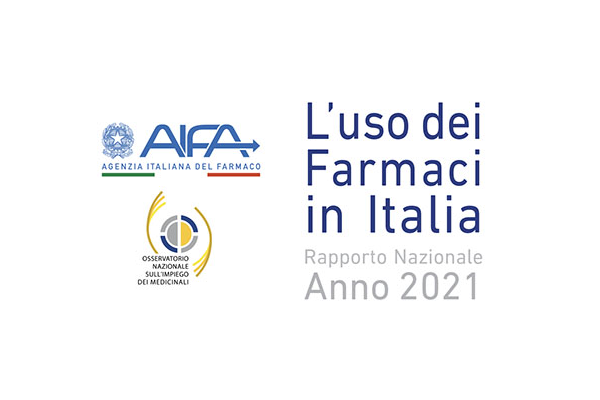It was presented on July 29th National Report 2021 "The use of drugs in Italy", accomplished 
We report some excerpts from the presentation of the Dr Nicola Magrini, AIFA General Manager
The National Observatory on the use of medicines (OsMed) publishes the 22nd National Report on the use of medicines in Italy (relating to the year 2021) with an increasingly exhaustive and critical description of pharmaceutical assistance, a central hub for the health protection, which, for the public component, commits a share equal to over 17% of health expenditure, to which are added a further 9 billion in private expenditure, i.e. paid directly by citizens.
Pharmaceutical expenditure in Italy should be considered overall under control, given that it is growing at a slower pace than the other components of health expenditure (staff, hospital assistance, etc.) even if with numerous areas for improvement for a prescription based on the best scientific evidence and more homogeneous throughout the national territory. However, it should be borne in mind that there is a sharp increase in spending on vaccines, antivirals and monoclonal antibodies for COVID-19 which amount to over 2.3 billion euros for 2021, necessary to deal with the recent and unexpected health emergency.
A particular comment should be dedicated to the new AIFA Notes which have marked an important change of orientation becoming known for pathologies (vit.D, respiratory, intravitreal and diabetes) and no longer for single drug, allowing a greater ability to address the prescription according to the best scientific evidence.
A critical and cautious note should be formulated on private spending (at the expense of citizens) which is a chapter in progressive increase in the last 10 years and will exceed 9 billion in 2021: this expenditure must be considered to all intents and purposes as sometimes improper health care expenditure and to be kept more under the magnifying glass of the actions of prescribing appropriateness and good use of drugs.
The Report, drawing from the various information flows and with its detailed analysis, highlights the information potential of our NHS, able to provide the necessary elements for the implementation and evaluation of policies for the sustainability of pharmaceutical expenditure. However, a cultural change is necessary that leads to at least a three-year plan (2022 - 2024) that defines programmatic objectives of the system in the context of the overall sustainability of the NHS of which AIFA is a part and provides greater elements of understanding to citizens and patients of like all the most expensive and most important chronic innovative therapies, they are guaranteed in Italy in a universalistic way (to all) and free of charge.
Francesco Trotta, manager of the HTA and Pharmaceutical Economics Sector, underlined the key messages of the Report: “Total pharmaceutical expenditure in 2021 is 32.2 billion euros (+3.5% compared to 2020), of which 69.2% is reimbursed by the National Health Service, with private spending growing more than public spending. The cost for each patient is 543.8 euros (of which 376.3 euros paid by the NHS). Most of the consumption is absorbed by the territory (87%), where chronic pathologies are mainly treated, with a lower cost (41%). Conversely, the consumption of drugs is lower in hospitals (13%), where acute or complex pathologies are treated, for a greater expense (59%)”.
On vitamin D, General Manager Magrini, announced that “a review of the Note 96 che aveva già determinato un utilizzo più mirato di questo farmaco”, producendo “un risparmio di diverse decine di milioni l’anno”. A sostegno di questa affermazione ha citato il recente item pubblicato sul New England Journal of Medicine (NEJM), che per altro tratta di un integratore e non di un farmaco. Nello studio viene dimostrato che la vitamina D3 supplementare (2000 U.I./p.d.), rispetto al placebo, non ha avuto un effetto significativo sulle fratture totali. I partecipanti non sono stati reclutati sulla base di carenza di vitamina D, massa ossea ridotta o osteoporosi. Gli end point primari erano le fratture totali da incidenti, non vertebrali e dell’anca. I modelli di rischio proporzionale sono stati utilizzati per stimare l’effetto del trattamento nelle analisi dell’intenzione di trattare. In sostanza assumere la vitamina D come integratore non offre alcuna protezione dalle fratture nell’anziano.
Lo stesso studio aveva già scoperto che assumere molta vitamina D non preveniva nemmeno le malattie cardiache, il cancro o la perdita di memoria. Lo studio, secondo il Dg Aifa Nicola Magrini, rende “a revision of Note 96 is likely soon”.
In “un editoriale di accompagnamento” firmato da “alcuni noti studiosi di osteoporosi”, gli esperti concludono che “we can no longer speak of vitamin D insufficiency except in extreme cases – ha riportato Magrini – che non ha senso misurare i livelli ematici di vitamina D come si faceva e si fa, e che le persone dovrebbero smettere di assumere supplementi di vitamina D per prevenire malattie importanti o estendere la durata della vita”.
______________________________
The case of Vitamin D
Da un punto di vista epidemiologico, riferisce OsMed, si stima che in Italia circa 3,5 milioni di donne e 1 milione di uomini presentino osteoporosi e i numeri paiono destinati a crescere con l’aumento previsto della popolazione ultra-sessantacinquenne nei prossimi 25 anni. Per quanto concerne le fratture, nella popolazione over cinquanta il numero annuale di fratture dell’anca si aggira intorno a 90.000, mentre si ritiene siano circa 70.000 le fratture vertebrali, verosimilmente sottostimate perché in buona parte asintomatiche.
La spesa per la vitamina D e analoghi (5,16 euro pro capite) rappresenta circa il 50% della spesa dell’ intera categoria con un aumento del 20% rispetto al 2020. Il motivo di questo Il incremento va attribuito principalmente al non dimostrato effetto protettivo contro il COVID e solo in parte alla fisiologica diluizione dell’effetto frenante della nota sulla prescrizione. Questo rilievo sottolinea l’ampio utilizzo di colecalciferolo e metaboliti per indicazioni extra-scheletriche per le quali gli RCT non hanno fornito prove di efficacia.
The burden associated with fragility fractures in Italy exceeds that associated with chronic obstructive pulmonary disease (COPD) and ischemic stroke, and when comparing costs associated with fractures and the total cost of healthcare, Italy has the highest proportion of expenditure destined to this problem compared to the other five countries included in the international report which compares the Italian situation with that of five other countries (France, Spain, UK, Sweden, Germany).
Study results demonstrate that despite the availability of effective preventive therapies and management approaches for fragility fractures, only 20% of patients are treated pharmacologically. “Each fracture increases the risk of sustaining a new fracture fivefold”, explains Prof. Maria Luisa Brandi, president FIRMO Foundation.
What exactly happens? The authorization to prescribe these drugs belongs only to a few authorized centres, while the general practitioner is limited in the choice: either to prescribe generic drugs or to prescribe the much debated vitamin D. “For this reason – noted Brandi in 2018 – in Italy there are many vitamin D prescriptions, unlike those of post-fracture drugs ".
Therefore, despite the existence of drugs and the provisions of Aifa (Italian Medicines Agency) to treat certain patients with this therapy, this is not done in Italy. “Perhaps a role in this whole story is to be attributed to the scandal calcitonin in the early 90s, when in Italy this drug was prescribed for osteoporosis and it didn't work. Surely – Brandi says – it was an episode that marked this area of medicine in a negative sense, but the situation could be unblocked with the issuing of guidelines that have legal value and that allow everyone to access therapies”. (Taken from Fractures and osteoporosis, the alarm of the experts)
Today, says Prof. Brandi, there is a much wider variety of osteoporosis medications available than ever before. The type of treatment you will be prescribed depends on your personal risk profile. The drugs have been shown to reduce the risk of hip fracture by up to 40%, vertebral fractures by 30-70% and, in some cases, to reduce the risk of non-vertebral fractures by 30-40%.
Your doctor may also prescribe calcium and vitamin D supplements to ensure you have enough of these important nutrients.
Today, says Dr. Luca Degli Esposti president of Colicon, the cost of a patient with a fragility fracture is a total of 6,500 euros in the year following the event: 1,000 euros for drugs, 4,500-5,000 euros for subsequent hospitalizations/procedures, 700 euros for tests/and other visits. The cost of a fragility fracture patient is significantly higher than the cost of patients of the same age and gender who have not experienced this event. This cost varies greatly according to the degree of compliance with the therapeutic recommendations which, according to the Note 79, they involve the use of drugs for osteoporosis, supplementation with calcium and vitamin D and their continuous maintenance over time. Compared to the average value of 6,500€, it ranges from a minimum of 4,000 for those who respect note 79 to a maximum of 9,000€ for those who do not respect it. The explanation for this difference is the hospitalization costs of the refractions. Therefore, greater compliance with the recommendations, lower risk of fracture events, lower overall care costs.
L’Istituto superiore di sanità ha pubblicato il 21 ottobre 2021 il documento su Diagnosis, risk stratification and continuity of care of fragility fractures, la prima linea guida nell’ambito delle fratture da fragilità del nostro Paese e una delle prime al mondo, realizzata dall’Università di Milano Bicocca in collaborazione con la Coalizione Frame (alleanza multidisciplinare e multiprofessionale con il coinvolgimento di 18 associazioni di pazienti) e il coordinamento di ALTIS-IHPB.
Related news:
Video Presentation OsMed Report 2021 "The Use of Medicines in Italy"
Supplemental Vitamin D and Incident Fractures in Midlife and Older Adults
Pubblicazioni simposio villa Donatello “vitamina D: istruzioni per l’uso”
Fratture da fragilità: un emergenza italiana – analisi del problema e sue soluzioni
Garattini: In the South, sun and sea, why are more drugs prescribed?
